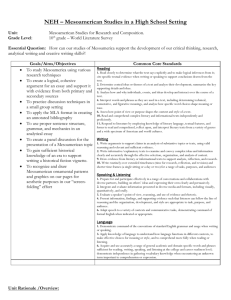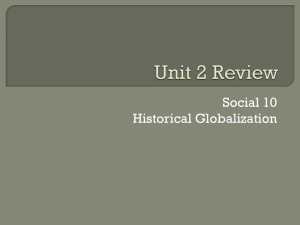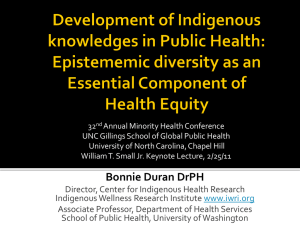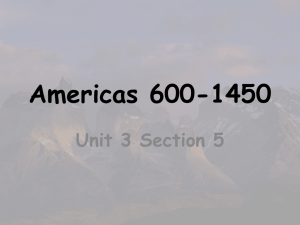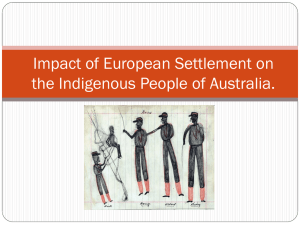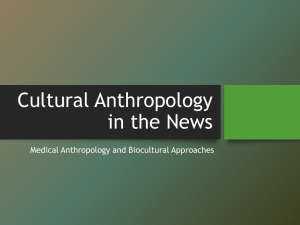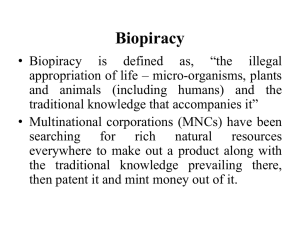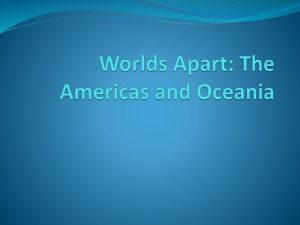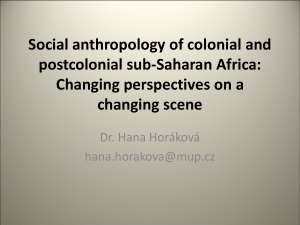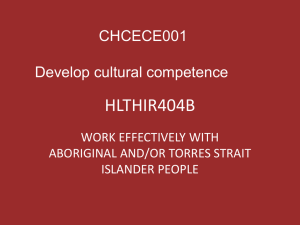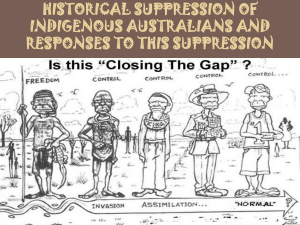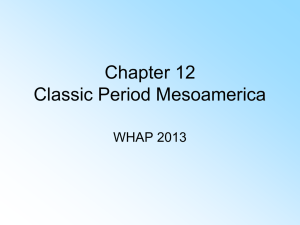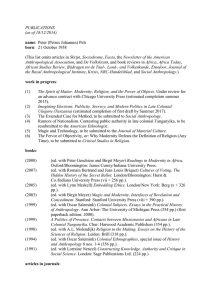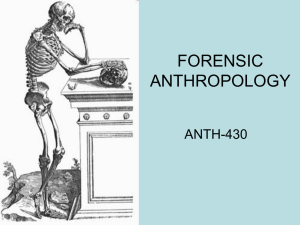Social Life of pre-sunrise (presentation)
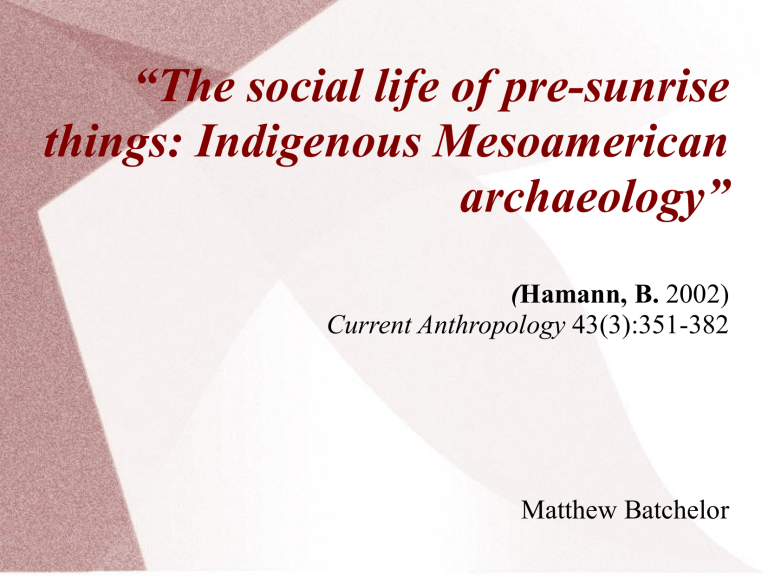
“The social life of pre-sunrise things: Indigenous Mesoamerican archaeology”
(Hamann, B. 2002)
Current Anthropology
43(3):351-382
Matthew Batchelor
Mesoamerica (Context)
→ As a cultural region, Mesoamerica is primarily defined by a collection of traditions developed and shared by numerous indigenous cultures.
→ Proceeding from the early domestication of staple products such as maize, cultural traits such as complex mythological and religious traditions, advanced agricultural systems, numeric and calender systems and distinct architectural styles, spread throughout the area and began defining cultures.
→ Communities developed into their own organised socially stratified hierarchies and consequently, into chiefdoms with the evolution of large ceremonial and administrative centres.
Article Overview
→ Hamann's study draws on archaeological, ethnographic, and historical sources to explore the traditions within indigenous
Mesoamerican archaeology.
→ It is common, when looking into this time period and region, to resort to using the culture-area concept of Mesoamerica. An interpretive structure, outlines this lengthy period and provides a framework.
→ Hamann uses three paired locations in his article: The Classic
(200–1000 CE) site of Teotihuacan and the 16th-century Mexica
Aztec capital of Tenochtitla. The Classic site of Yucun˜ udahui and the 16th-century Mixtec community of Chachoapan; and the
Postclassic (1000–1521 CE) site of Chichen Itza and The 20thcentury Yucatec Maya community of Chan Kom.
Teotihuacan & Tenochtitla
Chichen Itza
Figure 1: http://www.lib.uci.edu/about/publications/exhibits/meso/mesolandscape2.html
Map of Mesoamerica. (With visual examples of some major sites)
Theoretical Approaches
→ Hamann has two primary theoretical approaches in his article:
1) He attempts to trace continuations in indigenous beliefs that can provide a link between artifacts from previous culture periods to present social uses.
2) Based on CF. Trouillot's publication in 2004, Global Transformations:
Anthropology & The Modern World:
“Spatial-temporal generalizations like Mesoamerica do not gain their interpretative strength from lists of recurrent cultural traits. Rather they become useful when they focus on enduring structures of social meanings”
. Within this temporal-spatial construct, Hamann traces continuities in indigenous beliefs that link artifacts from “the past” to social life in “the present”.
Wider Theoretical Approaches
→ The very concept of “social life” is that the material thing(s) may have the potential to act in our world in the same way humans do.
→ Kopytoff (1986) - Objects are used and reused, their forms and meanings are transformed alongside. Entire classes of objects may be reused and reinterpreted. Hamann's discussion of the social life of archaeological remains focused on the interpretation as survivals from a previous age of creation. And this “survival” needs to be considered beyond merely material endurance.
→ Abu El-Haj (1998) “Distinguishing archaeologies that produce
“new material culture” and thus transform the physical and social spaces of their present.”
Methodological Approaches
→ Examining the ethnographic histories of the cultures in the region.
→ Comparing the current use of important cultural sites with how the same groups thought it used to be used.
→ Examining Historical records, both from the contemporary languages and tribes still existing today who claim roots back to these early pre-sunrise civilisations.
“Original-Debt”
→ What is it?
The emergence of the present from the past involved the creation of debts with the supernatural, debts that humans had continually to repay.
→ Where is it?
This concept is found throughout Mesoamerica. Its the repayment of the gods through sacrifice. A basic “existential proposition” of human existence.
Social memories about the past were mortared to social hierarchies in the present by embedding original-debt in the materials of dayto-day life.
Michael, E, Smith: Reply to
Hamann's Article
→ Smith states that Hamann’s model does not sufficiently account for the role of social class in structuring attitudes and behaviour concerning the past. It is smith's primary belief that ruling and elite classes were far more deeply involved with “pre- Sunrise things” in ancient Mesoamerican societies than commoners were.
→ “Hamann is correct that appreciation for ancient objects was a widespread phenomenon and an important cultural trait in Mesoamerica.”
Yannis Hamilakis's Reply to
Hamann's Article
→ Yannis states “Hamann’s paper is an important addition to the discussion on the diverse cultural biographies of material culture.”
He takes the main idea to be that the monumental landscape created by the presence of material of the past has inspired many social groups to develop their own distinctive forms of historical narratives; their own “indigenous archaeologies.
→
Yannis's concluding note is
“But while we should recognize the capacity of all social groups to produce historical narratives, we should also be sensitive to the complexities of this process of production, in which self and other are often mutually constituted.”
Conclusions
→ Location-based socialisation can be noted as a major influence on present groups in actively shaping the next generations identity and social existence.
→ In Mesoamerican social theory the social lives of objects and locations, the supernatural forces they house, and the social identity of communities are all closely linked.
→ Hamann’s views regarding the topic of long-term structures keenly seeks to move away from the popular idea that cultural meanings are simply constructed to serve social and economic factors.
→ There has been a number of replies to the article stating misinterpretation of evidence (Michael Smith, 2002) or forcing parallels between European ideologies (Ian Hodder, 2002).
Bibliography
→ Abu El-Haj, N. (1998). "Translating truths: Nationalism, archaeological practice, and the remaking of past and present in contemporary Jerusalem."
American Ethnologist 25 (2): 1-23.
→ Hamann, B. (2002). "The Social Life of Pre‐Sunrise Things: Indigenous
Mesoamerican Archaeology." Current Anthropology 43 (3): 351-382.
→ Hodder, I. (2002). "The Social Life of Pre‐Sunrise Things: Indigenous
Mesoamerican Archaeology." Current Anthropology 43 (3): 373.
→ Hamilakis, Y. (2002). "The Social Life of Pre‐Sunrise Things: Indigenous
Mesoamerican Archaeology." Current Anthropology 43 (3): 372.
→ Kopytoff, I. (1986). The Cultural Biography of Things: Commoditization as Process. Cambridge, Cambridge University Press.
→ Smith, M. E. (2003). "What Did Mesoamerican Commoners Think about
“Pre-Sunrise Things”?" Current Anthropology
44 (2): 271-273.
→ Trouillot, C. F. (2004). Global Transformations: Anthropology & The
Modern World, Palgrave Macmillan.
Figures
→ Figure 1: Splendours (N/A). Map of Mesoamerica. http://www.lib.uci.edu/about/ publications/exhibits/meso/mesolandscape2.html. U.
O. C. Irvine
